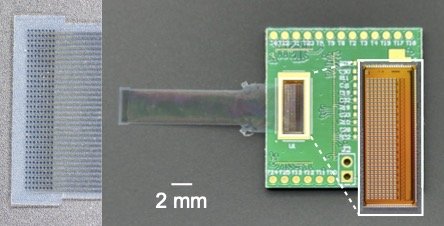Research
CMOS brain machine interfaces
We are developing better tools for scientists and clinicians to interact (recording and stimulation) with the brain and the peripheral nerves at-scale and with reduced invasiveness. Towards this goal, with colleagues at Seoul National University, we pursue two research directions:
Developing flexible, large-scale, high-resolution CMOS bioelectronic neural implants.
Understanding how the nervous system interacts with these devices.
The research is multi-disciplinary, involving: CMOS microelectronics circuits, cleanroom micro/nano-fabrication, embedded FPGA systems, software and algorithm development (including CUDA GPUs) and in vivo / in vivo biological experiments. Significant amount of computational modelling is also used, to help study the effects of electrical neuromodulation in complex neural tissue.
Peripheral nerve & spinal cord neural implant
There is growing recognition that significant knowledge gap remains in our understanding of neural circuits in the spinal cord and in the peripheral nervous system (PNS). A major roadblock for scientific progress in these neural systems is the lack of suitable investigative tools. With colleagues at SNU, DGIST and Delft University, we address this shortfall in the biologists' and neural engineers' experimental toolkit by developing miniature electrophysiological devices supported by wireless technologies and electrode arrays for dense recording and stimulation of the PNS and spinal cord, enabling chronic, awake-behaving neuroscience studies.
Miniature sub-dermal biosensors
CMOS microelectronics enable significant miniaturisation of devices with complex functionalities. Working with colleagues at UNSW SPREE, we are developing mm-scale sub-dermal implants for wireless biosensing.
Retinal implants
We are designing more effective implants for restoring sight to the profoundly blind. We have a strong emphasis on (1) understanding how the retinal neuronal network responds to electrical stimulation, and (2) how artificial electrical stimuli, generated by retinal implants, could be controlled to maximize the perceptual efficacy of these medical devices.
We address these research aims through biological experiments and computational modelling.
Wearable smart textiles
We also have ongoing collaboration with the group of Dr Thanh Nho Do, who leads the UNSW Surgical Robotics Lab, on wearable therapeutic textiles. These wearables incorporates electronics, sensors and actuators, all integrated / woven as part of the fabric, to enable continuous monitoring and to provide assistive technologies such as haptic feedback. The applications are wide-ranging, from clinical monitoring / diagnostics for patients with arthritis, to virtual reality devices in entertainment.













